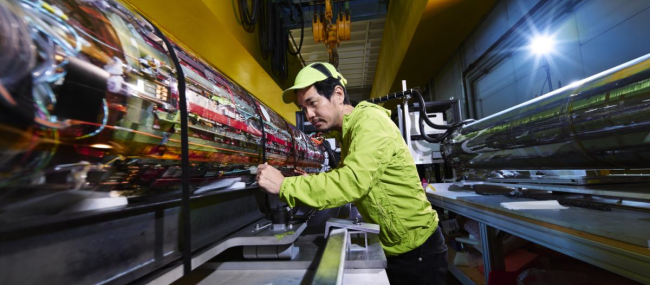
Canadian laser system used to cool antimatter to near absolute zero
By DE Staff
GeneralWorld first achievement opens new wave of antimatter research.

ALPHA-Canada spokesperson, Dr. Makoto Fujiwara, with the ALPHA Experiment apparatus at CERN. (Photo credit: Maximilien Brice)
“Today’s results are the culmination of a years-long program of research and engineering, conducted at UBC but supported by partners from across the country,” said Dr. Takamasa Momose, the UBC researcher with ALPHA’s Canadian team who led the development of the laser. “With this technique, we can address long-standing mysteries like: ‘How does antimatter respond to gravity? Can antimatter help us understand symmetries in physics?’ These answers may fundamentally alter our understanding of our Universe.”
Having the opposite charge of regular matter, anti-matter will annihilate on contact with matter, making it very difficult to create or experiment on. Laser manipulation and cooling of ordinary atoms has been in use for 40 years, but tests run with the ALPHA laser-based system marks the first time scientists applying the technique to antimatter.
“It was a bit of crazy dream to manipulate antimatter with laser,” said Dr. Makoto Fujiwara, ALPHA-Canada spokesperson, TRIUMF scientist, and the original proponent of the laser cooling idea. “I am thrilled that our dream has finally come true as a result of tremendous teamwork of both Canadian and international scientists.”
The Canadian effort was led by researchers and students from ALPHA-Canada (TRIUMF, UBC, Simon Fraser University, the University of Calgary, and York University) and contributors the University of Victoria and BCIT.
Going forward, Dr. Fujiwara and Dr. Momose say they now lead a Canadian project, called HAICU, to develop new quantum techniques for antimatter studies. “My next dream is to make a ‘fountain’ of anti-atoms by tossing the laser-cooled antimatter into free space,” said Dr. Fujiwara. “If realized, it would enable an entirely new class of quantum measurements that were previously unthinkable.”
“Furthermore, we are one step closer to being able to manufacture the world’s first antimatter molecules by joining anti-atoms together using our laser manipulation technology,” Dr. Momose added.
The ALPHA program’s antimatter research began in 2011 with the creation and trapping of antihydrogen for a world-record one thousand seconds. The collaboration also provided a first glimpse of the antihydrogen spectrum in 2012, set guardrails confining the effect of gravity on antimatter in 2013 and showcased an antimatter counterpart to a key spectroscopic phenomenon in 2020.
https://alpha.web.cern.ch
